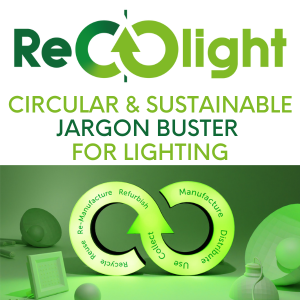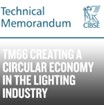CIRCULAR & SUSTAINABLE JARGON BUSTER
The adoption of the Circular Economy for truly sustainable lighting has seen the introduction of many new metrics, regulations, standards, and assessment methods.
The Recolight jargon buster aims to help demystify these for you. Links are included for more information.
If you think there is anything missing, or an update is needed, please get in touch.

All things sustainable & circular for lighting
Where they’re used
Global | European Union | United Kingdom
BS 8887 Remanufacturing | British Standards for the process of remanufacture.
BS 8887-220:2010 – Design for manufacture, assembly, disassembly, and end-of-life processing (MADE).
BS 8887-220 specifies requirements for the process of remanufacture.
A proposed new part of the BS 8887 series specifies the process of remanufacturing luminaires. It emphasises the need for a remanufactured luminaire to be supported by robust technical documentation, testing and compliance assessment.
It lists the steps required to change a used product into an as-new product, with at least equivalent performance and warranty of a comparable new replacement product. This remanufacturing process can include parts or components to be used in subsequent assembly.
UK Standard for remanufacturing

BS8887 Code of practice for the remanufacture of luminaires has been made available for public comment on scope and purpose.
You have until 27 April ’23 to respond. Follow this link to learn more. British Standards Institution – Project (bsigroup.com)
BS EN 4555 | BSI Circular economy standards within the CENELEC EN4555X series. These include :
BS EN45552 ‘Durability’
BS EN45553 ‘Remanufacture’
BS EN45555 ‘Recyclability’
BS EN45556 ‘Reused components’
BS EN45557 ‘Recycled Content’
BS EN45558 ‘CRM’
BS EN45559 ‘Information’
European Standard for circular product design
BREEAM® is a suite of validation and certification systems for sustainable built environment.
The BREEAM® suite of schemes enables consistent and comparable assessment and verification across the entire built environment lifecycle.
Global building certification | Lifecycle
CBAM | Carbon Border Adjustment Mechanism
An EU’s initiative to reduce so-called ‘carbon leakage’ – i.e., companies based in the EU could move carbon-intensive production abroad to take advantage of lax standards, or EU products could be replaced by more carbon-intensive imports.
In 2020, the UK Government launched a consultation which proposed how the Carbon Emissions Tax would operate if it was introduced from 2023 and proposes how the tax might be developed.
EU Carbon Taxonomy

CEAM | Circular Economy Assessment Method of TM66 (see below)
For analysing and scoring the circular attributes of luminaires
Cradle to Cradle Certified® is a global standard for products that are safe, circular and responsibly made.
Carbon & Circularity | Global Standard
CSRD | Corporate Sustainability Reporting Directive
An EU ESG (environmental social governance) directive designed to make corporate sustainability reporting more common, consistent, and standardized like financial accounting and reporting.
EU Directive
DPP | Digital Product Passport – product-specific data set.
Providing information on the origin, composition, repair, and disassembly options of a product as well as how the various components can be recycled.
EU Directive
EcoVadis is an assessment process which evaluates the sustainability of a business and its supply chain.
Carbon Assessment
Embodied Carbon
Embodied emissions are those that took place in the supply chain to manufacture, transport and install a product and all its components, as well as to dispose of it at the end of life.
Operational carbon emissions are related to energy and resource use during the product’s lifetime.
In lighting the operational emissions (~90%) massively outweigh embodied emission (~10%)
Lighting accounts for nearly 5% of global CO2 emissions1
1 Source: https://www.theclimategroup.org/led

Carbon Assessment
EPBD | Energy Performance of Buildings Directive is undergoing a recast and received the support of the European Parliament in a plenary vote on 14 March. It upgrades the existing regulatory framework to reflect higher ambitions and more pressing needs in climate and social action, while providing EU countries with the flexibility needed to take into account the differences in the building stock across Europe.
EU Life cycle assessment
EPD | Environmental Product Declaration is defined by the International Organization for Standardization (ISO) 14025 as a Type III declaration that “quantifies environmental information on the life cycle of a product to enable comparisons between products fulfilling the same function.” The EPD methodology is based on the Life Cycle Assessment (LCA) tool that follows ISO series 14040
It consists of two key documents:
- The underlying Life Cycle Assessment report: a systematic and comprehensive summary of the LCA project to support the third-party verifier when verifying the EPD. This report is not part of the public communication.
- Public EPD document that provides the LCA results and other EPD content.
Global Life cycle assessment
EPREL | European Product Registry for energy labelling
As of 1 January 2019, suppliers (manufacturers, importers or authorised representatives established in the EU) must register their products in the European Product Registry for Energy Labelling (EPREL). In May 2022, the database was launched for public access and consultation.
EPREL offers detailed information on models placed on the EU market by scanning the QR code featured on the new energy labels. The database provides information such as the luminous flux, colour temperature and cap type.
EU Regulation
ESPR | Ecodesign for Sustainable Products Regulation
The proposal for a new Ecodesign for Sustainable Products Regulation, published on 30 March 2022, is the cornerstone of the EU Commission’s approach to more environmentally sustainable and circular products. The proposal builds on the existing Ecodesign Directive, which currently only covers energy-related products.
30 new delegated acts expected to be developed by 2030 as part of ESPR
EU Regulation
ESG | Environmental, Social, and Governance reporting
In April 2022, the UK enacted two mandatory ESG disclosure laws. The new rules will ensure consumers and investors have access to information they need to assess risks arising from climate change and other sustainability issues. It will also create a culture of transparency regarding the impact companies have on people and the environment.
The Companies (Strategic Report) (Climate-related Financial Disclosure) Regulations 2022
The Limited Liability Partnerships (Climate-related Financial Disclosure) Regulations 2022.
Certain large companies within the EU must disclose ESG information under the Non-Financial Reporting Directive (NFRD).
A classification system that helps companies and investors identify “environmentally sustainable” economic activities to make sustainable investment decisions. Environmentally sustainable economic activities are described as those which “make a substantial contribution to at least one of the EU’s climate and environmental objectives, while at the same time not significantly harming any of these objectives and meeting minimum safeguards.
Under new EU rules, large, listed EU companies started in 2023 to report against the Taxonomy’s two climate objectives – climate change mitigation and climate change adaptation. First reports from this year are also becoming available, which now also include information on the Taxonomy’s other four environmental objectives
Guidelines
LCA | Life-cycle assessment
Methodology for assessing environmental impacts associated with all the stages of the life cycle of a commercial product, process, or service. Environmental impacts are assessed from raw material extraction and processing (cradle), through the product’s manufacture, distribution and use, to the recycling or final disposal of the materials composing it (grave).

Global methodology

LCAs are provided by several consultants and are very comprehensive, but can be costly, especially if your company has a large portfolio of products to assess.
- LCA’s will be expected with all new product designs.
- If carbon is taxed, then the spotlight will be on quantifying and validating carbon emissions.
- Likely to be adopted at European level as common assessment method.

LPC | Living Product Challenge
A framework that encourages manufacturers to create products that are healthy, inspiring and give more than they take across their life cycles.
Guidelines
PAS | Publicly Available Specification
Guidelines
PAS 2050 | Specification for the assessment of the life cycle greenhouse gas emissions of goods and services
PAS 2050 is the first consensus-based and internationally applicable standard on product carbon footprinting that has been used as the basis for the development of other standards internationally.
Standard
PCR | Product Category Rules provide the rules, requirements, and guidelines for developing an EPD for a specific product category.
Guidelines
PEPecopassport® PSR 0014, an international reference program for environmental declarations of products from electric, electronic and heating & cooling industries.
The association defines, in compliance with the ISO 14 025 requirements, the PEPecopassport® Program management process, with respect to professional ethics and transparency. Program currently supported by Lighting Europe
Environmental declaration methodology
PPT | Plastic Packaging Tax – High embodied carbon assessments will result in higher taxation
UK Taxonomy
SPI | Sustainable products initiative
This initiative, which will revise the Ecodesign Directive and propose additional legislative measures as appropriate, aims to make products placed on the EU market more sustainable.
UK Taxonomy
TM65 Embodied carbon in building services
Method for calculating embodied carbon in building services. A dedicated lighting version is being written by CIBSE; SLL.
Embodied carbon is understood as the greenhouse gas emissions (GHG) associated with the making of a product, its installation, its maintenance, repair, replacement, and then its end of life. It covers the whole life cycle, excluding operational aspects and the potential recovery, reuse or recycling of materials,

Environmental declaration methodology
Life Cycle Assessments
TM66 | Quantified Circularity – Creating a circular economy in the lighting industry
CIBSE and SLL Technical Memorandum for the lighting industry.
TM66 is a new Circular Economy Assessment Method, for designers, specifiers, and engineers, allowing the quick comparison of two or more lighting products.
It includes a new Circular Economy Assessment Method, designed to create an overall assessment of the circularity of a product on a 0-4 scale.

Circular Economy Assessment
WELL v2 | International WELL Building Institute
The WELL standard is currently focused on the promotion of good quality lighting, used in conjunction with natural daylight and the embodiment of state-of-the-art circadian principles.
Future drafts will include the demand for circular solutions, adding weight to products that have circular principles and/or are capable of being remanufactured in the future
Building Regulations
WLCA | Whole Life-Cycle Carbon Assessment
Whole Life-Cycle Carbon (WLC) emissions are the carbon emissions resulting from the materials, construction and the use of a building over its entire life, including its demolition and disposal. A WLC assessment provides a true picture of a building’s carbon impact on the environment.
Building Regulations
